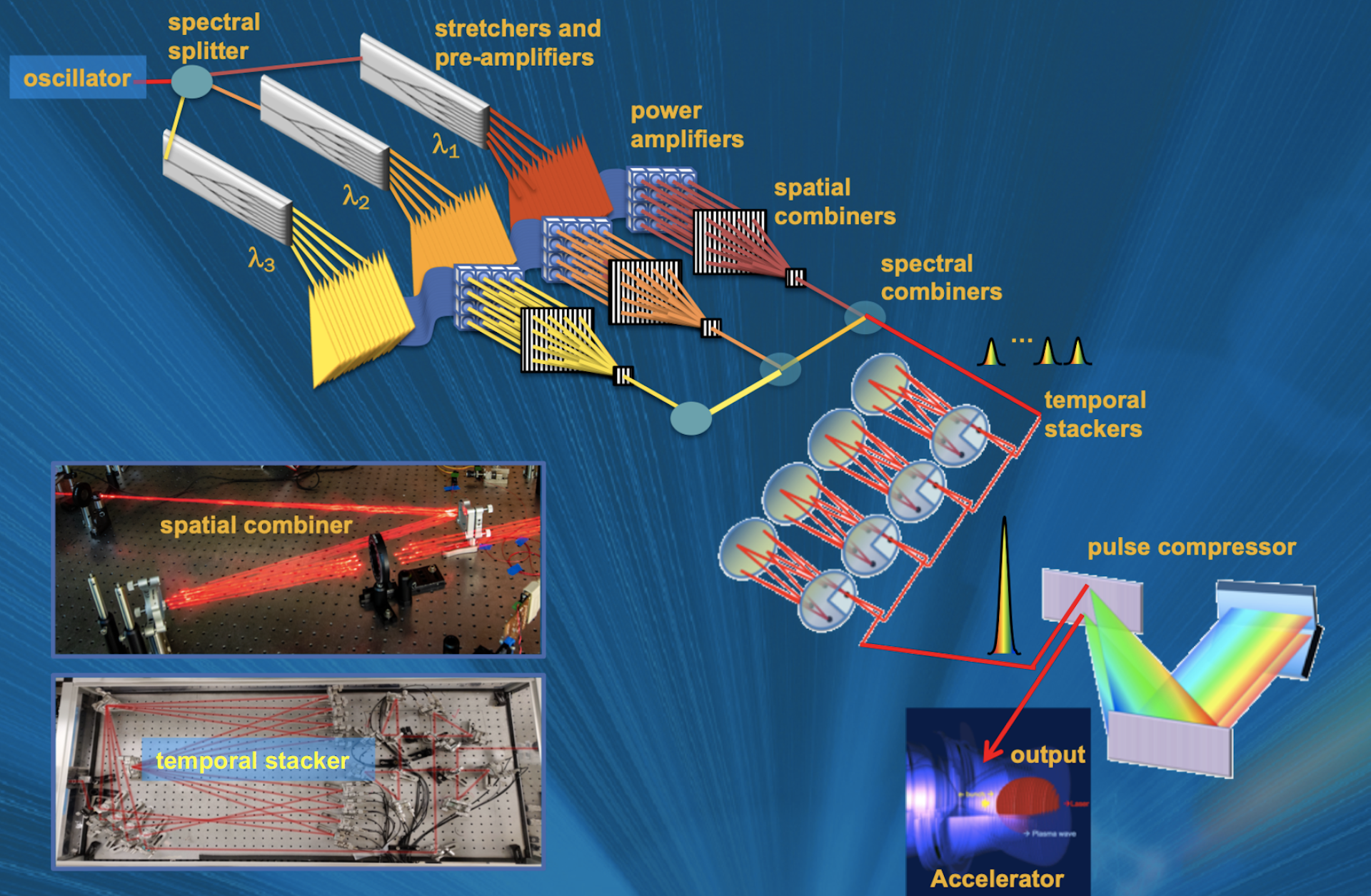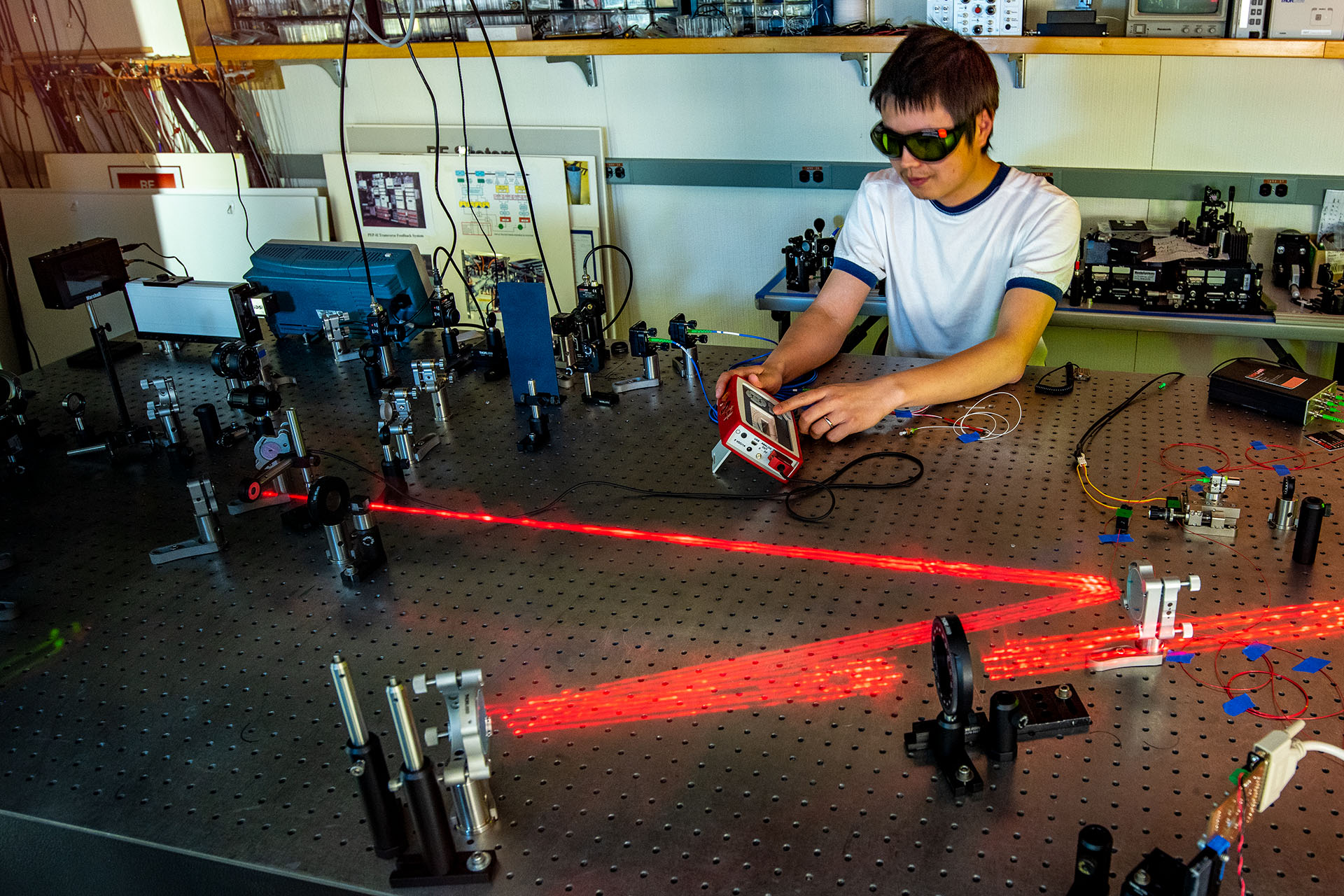The next phase in the development of laser-plasma particle accelerators (LPAs) – potentially game-changing tools for research and practical applications – is underway at the Department of Energy’s Lawrence Berkeley National Laboratory (Berkeley Lab). A new approach to high-power lasers – combining the pulses from many fast-acting but lower-energy optical fiber lasers – will energize these super-compact accelerators.
Berkeley Lab researchers have zeroed in on the limitations of LPA development efforts and believe they have found a new path forward with optical fiber lasers.
Cameron Geddes, director of Berkeley Lab’s Accelerator Technology and Applied Physics (ATAP) Division, said, “With all the recent technological breakthroughs in fiber lasers and laser-plasma accelerators, it’s time to bring them together – to develop a next generation of compact and precision-controllable accelerators that can be used in a wide range of applications.”
LPAs: Small is the new big
LPAs, in which the Berkeley Lab Laser Accelerator (BELLA) Center is among the leaders, are a radically compact approach to particle acceleration, notable for achieving particle energies in centimeters that would require tens of meters with conventional technologies.
Conventional accelerators use microwaves in resonant metallic cavities to impart high energies to beams of subatomic particles. This mature technology, which can take several circular or linear forms, makes accelerators powerful engines of scientific discovery, in addition to numerous practical applications in medicine, industrial processing, and national security. Many of them are, however, large and costly.
LPAs offer an alternative way to accelerate and boost the energies of the particles. Rather than using microwaves, an intense beam of laser light fired through a gas will generate a plasma wave that charged particles can ride like a surfer.
Radically smaller than present-day means of achieving the same beam energy, LPAs would be attractive in many applications, ranging from biomedical treatment to free-electron-lasers research centers to nuclear nonproliferation. Ultimately they might even be the basis for a new generation of colliders, orders of magnitude smaller than today’s, for high-energy physics.
LPAs have been successfully demonstrated (BELLA Center holds the record, having accelerated electrons to an energy of 7.8 billion electron-volts in just 20 cm), but they require high laser power. A laser like the BELLA Petawatt produces output comparable to the entire output of the world’s electrical grid for an extremely brief instant, focused into a pulse the diameter of a human hair. However, it can only muster a pulse every second or so. Useful applications will require high laser power delivered in much more frequent pulses. That’s where the new fiber laser project comes in.
Laser teamwork means powerful pulses
Fiber lasers (based on optical fibers that are like those familiar from telecommunications and computer networking, but designed for optimal laser emission) are fast, but small. Each optical fiber provides a channel no wider than a human hair, and can only emit so much power. The project now getting underway – building upon several years of groundwork at Berkeley Lab, the University of Michigan, and Lawrence Livermore National Laboratory – will further develop a scheme called “coherent beam combining.” The goal is pulses energetic enough to drive an LPA, but delivered a thousand times a second.
The new project is led by Berkeley Lab researcher Tong Zhou. Berkeley Lab team members working on fiber laser development also include Russell Wilcox, Qiang Du, Thorsten Stezelberger, and Jeroen van Tilborg. Almantas Galvanauskas and his students at the University of Michigan and Leily Kiani at Lawrence Livermore National Laboratory also play important roles in the program.
The overall effort, continuing to build upon several years of progress, involves spatial, temporal, and spectral combining in a way that preserves “coherence” (a distinctive quality of laser beams, necessary for LPAs). It aims to bundle the relatively low-powered pulses from many fibers into 30-50 femtosecond long, 200-millijoule pulses with peak power much greater than one terawatt. This would be the highest energy and peak power ever obtained from a fiber laser, and more than sufficient for demonstrations of laser-plasma acceleration.
“Their power consumption would be improved compared to conventional lasers, and their ability to dissipate heat is excellent, addressing other challenges in building high-power lasers,” Zhou said.

Combining laser beams so that they truly resemble one powerful beam is challenging. The next steps being taken by the project that recently commenced, headed by Zhou, a scientist in Berkeley Lab’s ATAP Division, and supported in part by the Gordon and Betty Moore Foundation, will build upon existing work on spatial combining, as well as amplification in doped fibers. Spectral beam combining (the subject of Zhou’s prestigious Early Career Research Program award from the Department of Energy’s Office of High Energy Physics) and temporal stacking are other ongoing aspects of the overall effort to produce a high-power kilohertz beam from fiber lasers. (Credit: Russell Wilcox, Tong Zhou, Almantas Galvanauskas, Cameron Geddes)
The long-term goal is a collider for high-energy physics. For those purposes, an LPA would need laser energy on the order of 10 joules in short pulses (30 to 100 femtoseconds each), with a repetition rate greater than 10,000 pulses per second – specifications far beyond existing laser technology. Fiber lasers are a promising candidate for solving this problem, and could in the meanwhile power the many spinoff applications of LPAs.
Power isn’t the only important thing in a system that has to deliver a hair-thin beam into a capillary with an inside diameter just a few times larger than that. Measurement and active feedback for precision control of such attributes as pointing angle and position are the subjects of complementary work at BELLA Center. Machine learning is emerging as an important control technique.
“We want to not only build a laser system that sets power and energy records, but also state-of-the-art controls, then use it to realize the first high-average-power, high-repetition-rate, laser-driven accelerator in the world,” Geddes said.
Such a system, coherently combining ultrashort pulses from many fiber lasers at a kilohertz repetition rate, is a frontrunner for the laser technology of kBELLA, the proposed next generation of the Berkeley Lab Laser Accelerator (BELLA) Center’s LPA drivers.
A newly awarded $2.4 million grant from the Gordon and Betty Moore Foundation, by way of the Berkeley Lab Foundation, will aid the coherent-combining work. The Gordon and Betty Moore Foundation fosters path-breaking scientific discovery, environmental conservation, patient care improvements and preservation of the special character of the Bay Area. Additional support is provided by the U.S. Department of Energy, Office of High Energy Physics Early Career Research Program and Accelerator Stewardship Program.
# # #
Founded in 1931 on the belief that the biggest scientific challenges are best addressed by teams, Lawrence Berkeley National Laboratory and its scientists have been recognized with 14 Nobel Prizes. Today, Berkeley Lab researchers develop sustainable energy and environmental solutions, create useful new materials, advance the frontiers of computing, and probe the mysteries of life, matter, and the universe. Scientists from around the world rely on the Lab’s facilities for their own discovery science. Berkeley Lab is a multiprogram national laboratory, managed by the University of California for the U.S. Department of Energy’s Office of Science.
DOE’s Office of Science is the single largest supporter of basic research in the physical sciences in the United States, and is working to address some of the most pressing challenges of our time. For more information, please visit energy.gov/science.
